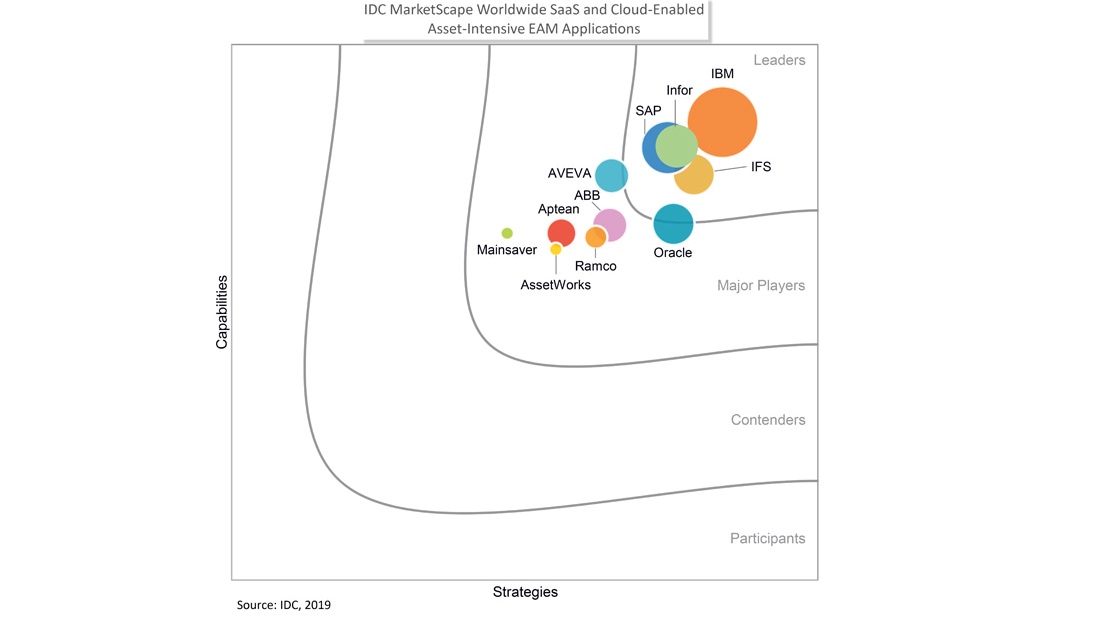Our Blogs
News
Empowering Reliability Leaders with IBM Maximo’s Predictive Analytics
Enterprise asset management (EAM) systems now have predictive analytic capabilities for anticipating potential failures, supporting continual improvement of the business. Assets are managed more effectively when enterprises make better use of their data to gain competitive advantage and enhance decision making. With those objectives in mind, the data that resides within an EAM system can be used to drive asset reliability.
Data-driven asset management is critical for modern maintenance programs to minimize downtime, optimize reliability and maximize value over the entire asset lifecycle.
Optimize Asset Performance with Maximo
IBM Maximo is the world’s leading EAM system and provides deep enterprise-level support for any asset type to drive operational efficiency across all organizations. A broad range of industrial sectors has deployed the IBM Maximo software to customize and implement reliability programs that optimize data management and improve asset performance.
“IBM Maximo helps reliability leaders manage their assets and data better to gain competitive advantages through improved business processes and enhanced decision making.”
Apply the Reliability Based Maintenance Method
Reliability based maintenance (RBM) is an example methodology used to develop a reliability program. RBM can help you determine the proactive approach that will deliver the most reliability for the least cost. Using RBM, evaluate existing maintenance programs to identify and eliminate non-value-added and intrusive tasks that contribute to asset downtime. Our partner’s reliability engineers apply the following proprietary method involving the following six (6) steps:
1. Identify assets that define your program
A reliability program starts with the identification of assets. Compile a list of assets within a structured hierarchy to be managed. When producing this master asset list (MAL), you will want to consider those data components specific to each asset that provide the ability to quickly group, sort and analyze large datasets. A normal operation can have anywhere from hundreds to thousands of assets depending on the operation size as well as how the asset is defined. When assets have the necessary number of common data components, they can be managed as a single asset group or management point. In the day to day asset management operation, reducing the number of management points is key.
2. Rank assets based on importance to the business
After the MAL has been developed and the asset groups formed, the next step is assigning an asset criticality ranking (ACR) value to assist in prioritizing your tactical and strategic efforts. When considering the criticality of an asset or asset group, it is important to look at all facets of how an asset’s failure can impact the business.
Our standard factors for ACR calculation are Operational, Utilization, Quality, Safety and Environment. We then provide a numeric value for a number of calculations performed, as well as classify the number into one of four classifications. These classes are ranked as Critical, High, Medium and Low.
Once your ACR or prioritization numbers are calculated, it’s important that these are then loaded into the EAM system. Using the Maximo 7.6 as an example, the out of the box functionality of ‘Priority,’ as part of the Assets application, is the ideal storage field for your criticality value. Once the ACR value is loaded into the Assets application, it will then automatically carry over to the Work Order Tracking application for use in prioritizing work orders. The affiliated ACR value will be automatically populated based on the asset value that is entered on the work order. This provides an enhanced prioritization mechanism for determining work order priority.
3. Optimize the PM program
Once asset groups are prioritized, we need to develop the necessary PMs and job plans. An external analysis is often required to perform preventive maintenance optimization (PMO). It is imperative that the outputs of these critical efforts make it into the EAM system for quick reference and data integrity management. How many times have you wondered how existing PMs and job plans were developed, and more importantly, what failure mode is driving their existence?
The primary purpose of ACR is to identify those assets or asset groups most important to the business. In a similar manner, the next level down is to evaluate those failure modes most important to the asset or asset group. The calculation used to classify failure modes is risk priority number, or RPN. The standard RPN factors we use are Severity, Likelihood and Detectability. This calculation is used to classify failure modes for both PM optimization and spare part analysis.
It is important to document both failure modes and proactive tasks in the EAM system, how they are linked and any affiliated risk calculation you may perform. The benefits of this are covered below in reliability analytics monitoring and root cause analysis (RCA).
4. Analyze Spare Parts
In addition to the PMs and job plans, we will also need to analyze and identify spare parts that are deemed critical based on ACR and PMO. Similar to the PMO effort, documenting the failure modes and affiliated spare part recommendations in the EAM system is imperative to justify what spares are stocked or registered as non-stock. Storing this information in the system for quick reference is equally important to that of the PMO effort.
One of the key analyses performed for inventory management is cycle count analysis (CCA). Our standard CCA factors are RPN, from the affiliated Failure Mode, along with Utilization, Material Cost, Lead Time and Inventory Turns.
As a reminder, the cycle count classification will drive the frequency in which a physical inventory reconciliation is performed. This classification should drive the routine cycle counting effort and therefore should be stored in the Maximo system. This provides you the ability to run reports out of the EAM system to manage the effort. The Maximo 7.6 out of the box functionality of ‘ABC Type’ as part of the Inventory application is a perfect storage location for your classification value.
5. Monitor Reliability Analytics
If all previous EAM system linking efforts were performed effectively, you will now be well-positioned to produce reliability analytics. Once the failure modes are listed in Maximo, with short pick lists specific to each asset group, these values can then be linked to reactive maintenance work orders. This provides you the ability to effectively analyze failure data since you do not have to depend on the work order description open text field that often times is very challenging to filter or decipher.
Using this work order data, a Pareto Analysis can be performed very quickly providing a line of sight to issues requiring correction.
6. Perform Root Cause Analysis (RCA) to Improve Problem Areas
And lastly, once key problem areas are identified, their root causes can be determined and remediated as a part of continual improvement. Since the relationship between failure modes and their affiliated proactive tasks and spare parts have been documented in the EAM system, now you can quickly make program improvements where needed.
RCA can then be performed on the assigned proactive task to determine the deficiency. Also, this failure data can and really should be used to update the Likelihood value of the RPN calculation since you will now have objective data to drive the analysis.
Manage Your Data in the EAM System
Whether your organization subscribes to the RBM methodology or a different one, there is a common objective all reliability professionals must face: ensuring that the data produced during the external analyses to develop a robust program is effectively transferred into Maximo or your EAM system of choice. It is important to manage your data in the EAM system and not in spreadsheets, databases or the like. Each analysis will have key outputs that should reside in the EAM system.
Implement a Predictive Maintenance Strategy
As a strategic IBM business partner, Avenue’s Solutions can help your organization develop and sustain effective, and predictive, maintenance programs that promote optimal asset reliability. By implementing an RBM strategy using the IBM Maximo EAM system, asset-intensive industries can improve equipment availability, uptime, productivity and product quality, while reducing cost, all at the same time.
The RBM approach provides effective and sustainable asset management strategies aimed at prioritizing and maintaining your most critical assets while also increasing efficiency, reliability and profitability over the long term.
Contact us for further consultant of predictive maintenance strategy that meet with your business requirement at info@avenue-net.com
Source: IBM’s partner – GenesisSolutions






